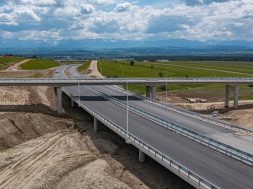Government is expected to focus on advancing spending on infrastructure projects

This step will revive the industry and the success of government efforts to spend heavily is likely to be constrained, depending in part on their current financial position and debt, says Pankaj Udeshi, Assistant General Manager Procurement, Supreme Infrastructure India Ltd.
What will be the new state of the affair after 2020 for the construction and infrastructure sector?
Covid -19 pandemic took the entire globe by shock and surprise. The physical workplace has been affected drastically, as nobody could have planned for downfall as severe as what we observed. Almost every country has been affected by the devastating coronavirus disease. The world is passing through a great uncertainty. Undoubtedly, the coronavirus has put the world economy at a major risk. There are, primarily, two major challenges that the Indian economy is facing at this juncture. First is to save the country from the spread of coronavirus which is a health emergency. Saving lives is the most important, the principal concern of the government. Second is to save the economy from the unfolding economic uncertainty due to the dual effects of the coronavirus pandemic and the global and national lockdown.
In the first quarter of last financial year (April to June – 2020) 70 per cent of construction activities fell due to Covid-19 pandemic as per CRISIL Research. We also witnessed a shortage of labourers, drivers and operators on the project and it brought construction activity to a halt. Public transport, including trains and buses, continue to remain suspended. Transporters, who are running only 10-15 per cent of their fleet, should use trucks for essential items to ensure that there are no supply issues. Initially, the movement of non-essential goods was allowed to clear highways of existing loaded vehicles. For delays in construction schedules due to supply-side issues like labour, equipment, and raw material disruptions for projects under construction.
The first phase of the Covid-19 crisis leaves important lessons on sustainability, governance and inter-institutional co-operation, particularly an emphasis on the use of information technologies, risk-based approaches, enhanced collaboration on national, regional and international level as well as open and innovative ways to promote dialogues between public and private stakeholders.
The construction industry, and its broader ecosystem, erects buildings, infrastructure, and industrial structures that are the foundation of our economies and are essential to our daily lives. It has successfully delivered ever more challenging projects, from undersea tunnels to skyscrapers. However, the industry also has performed unsatisfactorily in many regards for an extended period. The Covid-19 pandemic may be yet another crisis that creates havoc on an industry that tends to be particularly vulnerable to economic cycles.
Given the financial constraints, what will be an appropriate partnership model for delivery and funding of infrastructure projects?
To start halted infrastructure projects in the country, the government requires huge Investments and in the face of Covid-19 pandemic and other constraints, the government needs a sustainable strategy to avert and mitigate such pandemics, and the response to India’s problem partly lies in elevating the public and private spend in the infrastructure sector through PPP (Public Private Partnership).
PPP involves a contract between a public sector authority and a private party, in which the private party provides a public service or project and assumes the substantial financial, technical and operational risk in the project.
To supplement the gravity of the problem, even when governmental actions to tackle Covid-19 could be categorized as a ‘Change in Law’, PPP contracts are divided on this approach vis a vis the determination itself and the relief. There is a dire need to relook at the PPP contracts to make them self-sufficient and to address the concerns of the stakeholders with appropriate risk allocation. Issues like capital availability, bankability, technological innovations, market conditions, and commensurate relief availability need to be stressed upon and incorporated in the PPP contracts. The government needs to reconsider the positions under the procurement guidelines that do not favour bilateral renegotiations of PPP contracts to address the extent of vulnerability Covid-19 has demonstrated that was neither foreseen nor envisaged.
PPP employs high leverage in terms of debt funding needed by private stakeholders. The rising NPA position in India has brought to forefront structural issues that need to be factored in and resolved for ensuring bankability of PPP Projects. Determining financial and technical plans, with a risk allocation structure appropriate for the nature of the PPP project, and the interests of the lenders, involving an acceptable credit risk is the need of the hour to ensure PPP is a success story and enough liquidity is maintained within the banking system.
The Kelkar Committee has stressed on these aspects, and if the aim is to drive PPPs with large scale private investment without burdening the banking system further, then the rules of the game must be redefined.
To bolster investor confidence including the private equity players, a robust pipeline of bankable projects is required, and the first step towards it in the form of National Infrastructure Pipeline (NIP) has already been taken. Now the NIP needs to be supported by revolutionary funding models, financial products and resolve of both the public and private sector.
There is a need to reboot the PPP framework, but this time with newer models, and on procedural side, with emphasis on project planning and regulatory framework, to enhance the viability of PPP projects in India. Government is also trying to bring more funds by foreign direct investment and bringing new technologies.
What kind of infrastructure upgrade initiatives should the government focus on to ensure the construction sector remains in robust health?
The pandemic has reached ‘community transmission stage’ in India, the key challenge faced by the states/Union Territory governments now would be to balance the pursuit of economic revival with that of adhering to the stringent guidelines.
Government is expected to focus on advancing spending on infrastructure projects to revive the industry. The success of government efforts to spend heavily is likely to be constrained, depending in part on their current financial position and debt.
The big challenge for the construction sector is the availability and management of working capital. Not paying off old dues to contractors and many contracts having milestone payment terms and milestone is yet to achieve, bank EMI payments were not made, these all problems feel business owner as stuck up and required support for the survival of business from the bank or through government policies.
The government realized that spending on infrastructures sectors will help in achieve economic growth and counter the effect of Covid-19. It will generate a good amount of employment and increase the turnover of cement, steel and transport industries and also correlation sale in construction equipments.
Approximately 24 per cent of National Highway Network in India is four lanes, therefore presents immense scope for Improvement. Government Initiatives like Housing for all and Smart city Mission will derive the growth of the sector.100 per cent FDI is permitted under the automatic route across various infrastructure sectors.
Currently, the Reserve Bank of India (RBI) announced that it will extend the scheme of co-lending to all non-banking financial companies (NBFCs). It has been decided to extend the scheme to all NBFCs, including Housing Finance Companies (HFCs), in respect of all eligible priority sector loans, and allow greater operational flexibility to the lending institutions.
There are hopes that the “co-lending model” will help leverage the comparative advantages of banks and NBFCs in a collaborative effort, and improve the flow of credit to the unserved and underserved sectors of the economy. RBI announcement of rationalizing risk weightage on home loans will encourage new home buyers, better revival of business in smaller towns it leads to expectation of further strengthening of rural economy.
Cookie Consent
We use cookies to personalize your experience. By continuing to visit this website you agree to our Terms & Conditions, Privacy Policy and Cookie Policy.









